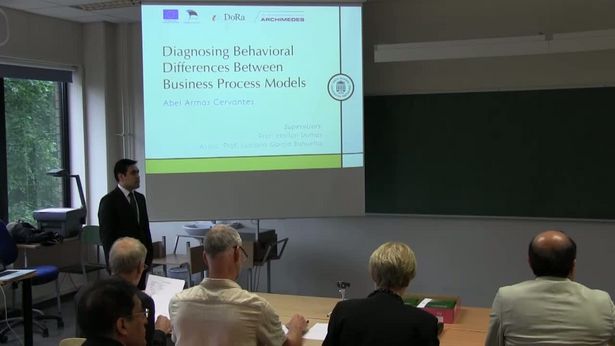
This is a modal window.
Beginning of dialog window. Escape will cancel and close the window.
End of dialog window.
<iframe width="560" height="315" src="https://www.uttv.ee/embed?id=23025" frameborder="0" allowfullscreen></iframe>
Business processes are the arteries of modern organizations. They determine how work is done in an organization. In large organizations, it is common practice that business processes are described in details in the form of business process models. Business process model helps business analysts and managers in an organization to better understand and to continuously improve the business processes of an organization.A mature organization will typically have accumulated a large collection of business process models. Sometimes, the same business process is described in the form of multiple variants. For example there may be one variant of sales process for selling products in the domestic market, and a different variant for selling products in different international markets. These multiple variants sometimes need to be compared and standardized in order to reduce costs or to create synergies between multiple teams and business units in an organization.The standardization of business process variants requires analysts to compare process models in order to determine how to reconcile them. Existing process model comparison techniques can be classified into those based on the structure of the models and those based on their behavior. In some cases, a structural comparison is sufficient to understand the differences between two process variants. However, two process models may be structurally different, yet behaviorally equivalent or they may be very similar structurally yet quite different behaviorally, as changes in a few nodes or edges in a business process model might imply major behavioral differences.In this context, this thesis approaches the problem of comparing pairs of business process models from a behavioral perspective. The main contribution of the thesis is a novel method to compare two business process models in order to determine if they are behaviorally equivalent. In case the two process models are not behaviorally equivalent, the proposed method produces sentences in natural language that describe accurately their behavioral differences.
The proposed comparison technique was implemented as prototype tool called BP-Diff. The tool takes pairs of process models described in a standard process modeling notation called BPMN, and describes the differences both by means of natural language statements and also visually. The tool is publicly available athttp://diffbp-BPDiff.rhcloud.com/
Parema kasutuskogemuse tagamiseks kasutame küpsiseid. UTTV veeb ei töötle ega kogu isikuandmeid. UTTV kasutab Google Analyticsi teenust. Loe lähemalt andmekaitsetingimustest.